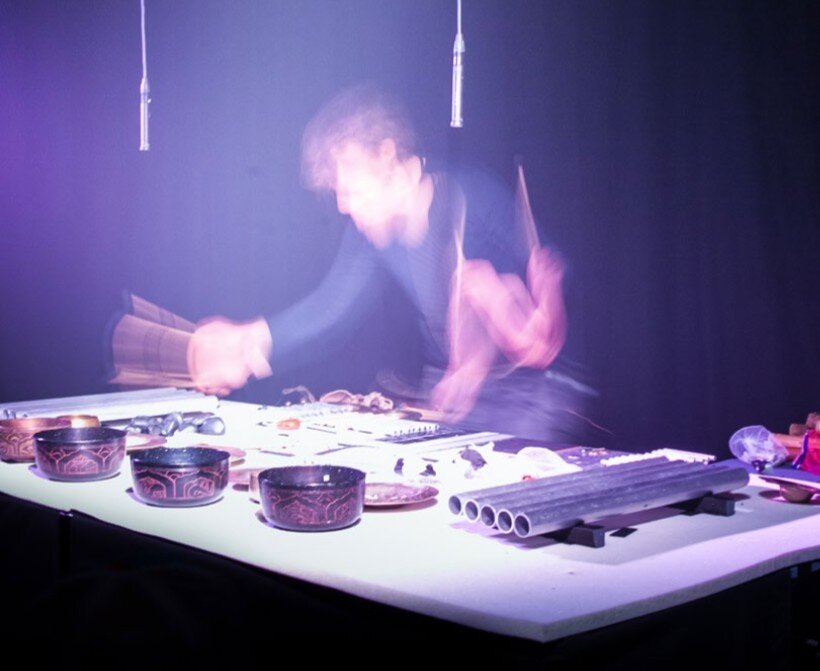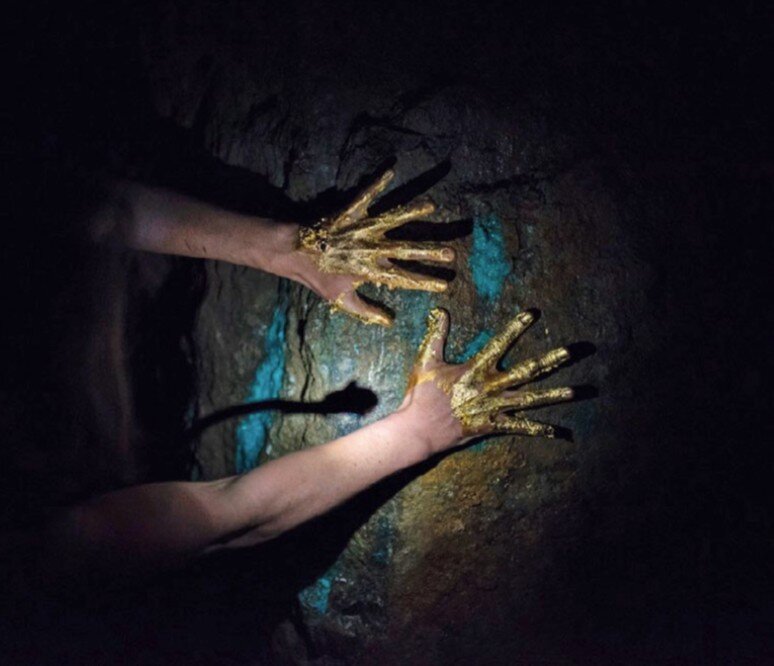Stepping Back from The Edge: Re-imagining Queenstown - by Cameron Hindrum
ISLAND | ISSUE 149photo by Gary Sauer-Thompson
The cold. For some reason, this I remember above almost anything else. I waited most mornings on the nature strip in front of my house for the bus to school. The cold had a savagery about it, as if it wanted to mirror the jagged edges of the hills around the town then uncrowned by trees. I hugged myself, watching the clouds of my breath puff and vanish, waiting desperately for a warm classroom so I could feel my fingers again. Queenstown, deep in the west of Tasmania, was a place of extremes, I had come to realise, but I could handle the heat of summer, when the houses tucked into the bottom of the gully behind Mount Lyell and Mount Owen were speared by sheets of heat deflected from those vast dolerite fortresses. Winter, with its claws of frost and so nights of snow, delivered me right to the end of the world: a place of vast and desolate silence.
That was more than thirty years ago now. The Mount Lyell copper mine was faring reasonably well, despite fluctuations in the global copper price and the occasional threat that if things didn’t improve it would have to close; things always seemed to improve just in time. They would blast in the mine semi-regularly and I remember my mother moving precious items back from the edge of the mantelpiece in the loungeroom, in preparation. It was nearly always a Saturday, I seem to recall, always around lunchtime. I was at the time entering the dangerous minefield of adolescence, and I had moved from my childhood home to live here: I had left friends and regular access to the ocean. There were no oceans here – we were at least an hour’s drive away. All of which is by way of saying that I really wasn’t overly fond of the place. Most of the kids at school were tough and aggressive (I wasn’t), it was wet, it was treeless, it was grey (at least in the emotional palette of my adolescent memory). So there I was.
The big question is: why, given my difficult memories of the place, has it inspired me so extensively? My first novel and my first play were both set there. The latter is what had me returning to Queenstown in October 2016, for its premiere at The Unconformity, the first iteration of the rebranded Queenstown Heritage and Arts Festival. I was quietly terrified about returning. Part of me felt that I had appropriated the town and its people for my work – I am not of Queenstown, so what am I doing laying it bare? The play is not especially affectionate either; its central coming-of-age story is a tender one tempered by revelations of appalling domestic violence which culminates in an act of manslaughter. It is bookended by tales of death – firstly of the (mostly) factual events surrounding the 1912 North Mount Lyell Mine fire, and secondly of the (mostly) fictional story of a local character who is taunted by the town’s young children until one of them stumbles upon his suicide. So I had genuine reservations about what the good people of Queenstown would make of the role I had given their town. (As it turns out, these were unfounded; reception, as far as I know, was positive – the consensus seeming to be, ‘Well, that’s how the town was back then’. The play is set during the time I lived there.)
I was aware, though, that the Queenstown to which I would return is a place facing long-term economic depression; owing to a couple of fatal workplace accidents, the Mount Lyell Mine had recently closed, and there seemed (and seems) to be no clear indication of when it will resume operation. Tourism, on the back of increasing growth in this sector in nearby Strahan, has perhaps helped soften the blow somewhat, but Queenstown is (or has been) defined by its holes in the ground and what was trucked out of them over many decades. Minerals built the town, and many others on the west coast, and without them one might wonder exactly where the future lies.
It might be too bold to imagine that it lies in the arts. However, there are many examples of arts festivals driving regional renewal, establishing new parameters of community engagement in areas that might otherwise have been written off, if not actually abandoned; and so it is, one dares to hope, with the Unconformity and its long-term plans for reshaping and rebuilding Queenstown as a destination du jour for artists across the full spectrum of disciplinary practice – dancers, sculptors, theatre-makers, photographers, writers, musicians and composers. After all, Queenstown is a place simply like no other; if Tasmania has a difficult postcolonial narrative fuelled by conservation on one hand and development on the other, Queenstown is where the hands applaud. Physically the town is reclaiming itself – trees have appeared on slopes that were barren for decades owing to prolonged mine activity (compounded by very high annual rainfall). But the scars remain, probably permanently, where the earth has been plundered for copper and iron ore and gold. Those scars – the rich rust-coloured belts of rock angling down towards the township from the surrounding hills, the geological entity that gives The Unconformity its name – are now the stuff of inspiration, the ashes before the fire is lit.
photo by Glenn Mead
How is it, I ask myself, that the frigidly cold, insular, incredibly distant town of the mid-1980s (it genuinely did feel like travelling to it was heading towards the very edge of the world) is now home to a diverse, poetic, challenging crossdiscplinary arts festival? Why have artists like Raymond Arnold, twice winner of the prestigious Glover Prize for landscape art, made Queenstown their base? There are probably no simple answers to such questions but I’ll concede that in describing the town as insular as I just have, it was no more insular than I was then, and no doubt there were parts of the town or elements of its community that I did not (or could not) see. Perhaps it is often the case that out-of-the-way places – away from major development, out of sight of shopping centres and malls – attract the creative spirit. And it has to be said that the landscape – both scarred and natural – around Queenstown is consistently spectacular. It invites reimagining, introspection. Perhaps, in one sense, it creates you.
The Unconformity was held for the first time in its new clothing in 2016 and it delivered a mercurial program of diversity, curated artistry, site-specific installations, dance, exhibited artworks, sculpture and performance. The festival also served to underscore Queenstown’s tourism profile – already in the ascendancy thanks to developments such as the West Coast Wilderness Railway. I attended a brief talk by Travis Tiddy, Director of The Unconformity, on the Saturday morning – held, fittingly, in a room at the rear of the Uniting Church Hall which was housing an installation called Suffering (the work of UK artist Lindsay Seers in response to the life’s work of an eccentric Queenstown artist, Leo Kelly). Travis spoke of the potential for The Unconformity to help redefine Queenstown over at least the next six years (the length of the current developmental plan for the festival). Queenstown is a place where the status quo is no longer good enough; not to push the mining analogy too far, but the bedrock of the local economy seems to be fractured and perhaps The Unconformity can provide some stability, or the promise of much-needed diversity.
(L) Melbourne musician Matthias Schack Arnott;
photograph by Glenn Mead;
(R) contemporary theatre by Melbourne performer Katrina Gill
in the Mount Jukes Mine;
photograph by Jack Robert-Tissot
While The Unconformity itself will be biennial, there are plans to hold more regular events under its umbrella – to bridge the gap, as it were, and to maintain the brand and its pulling power until such time as the main show is mounted again. Tiddy spoke that morning – and the idea still resonates with me – of ways in which The Unconformity could become central to a rejuvenation of Queenstown or, at least, of a version of Queenstown no longer dependent on extracting resources for survival. Of a Queenstown which straddles an odd cultural fissure – a place of material wealth once derided by many as a silent and mostly avoidable backwater, now celebrated as a place of innovative arts practice with the jaw-dropping scenery to match.
According to Travis Tiddy, a high number of visitors to The Unconformity reported that it changed their perception of the town. Perhaps more pragmatic change begins with vital but rather slower shi s in such perceptions. That the arts could catalyse such a transformation is, at the very least, enthralling; that such a transformation, so catalysed, could also have profound and enduring economic benefits seems incredible. But there it is, seeded among that collection of humble houses gathered in the cold at the bottom of a distant valley crowned by those majestic and unforgiving peaks: the arts as a site of renewal.
*
On my last afternoon in Queenstown I walked up Spion Kop with my daughter. Almost right in the centre of town, this hill offers expansive lookouts over the houses and hills beyond. A structure representing a mine shaft headframe has been erected there, and I’m told that most Sunday mornings a bagpiper can be heard skirling away. Someone has inscribed phrases into little plaques and left them in random places along the path to the top and I took a photo of one that I thought was especially apt.
author’s photo of artwork by Selena de Carvalho
Art should, perhaps, be fearless. Artists should be fearless. The good people of Queenstown should be fearless. It was cold at the summit of the Kop and threatening to rain, both conditions that I remembered all too well from those endless mornings nearly a lifetime ago, waiting for the school bus: but they didn’t bother me that afternoon. My play had been very warmly received and perhaps I was insulated by that. However the transformation had occurred, the town below me was not the town of my youth – I’m not entirely sure what it is any more, and I suspect I have The Unconformity to thank for that. It is a place of possibility, of choice – a place, finally, of ideas: the last and most durable of the resources to be extracted from the intricate geological layers into which Queenstown is nestled, like a waiting bird in an ageless nest.▼
The Unconformity Cup,
a football match on Queenstown’s famed gravel football oval;
photograph by Jack Robert-Tissot
Cameron acknowledges the contributions of Travis Tiddy to this article,
and thanks Mudlark Theatre and The Unconformity for bringing
I Am A Lake to the Tasmanian stage.
thumbnail image by Marc Pricop
This arts feature appeared in Island 149 in 2016. Order a print issue here.
If you liked this piece, please share it. And please consider donating or subscribing so that we can keep supporting writers and artists.






